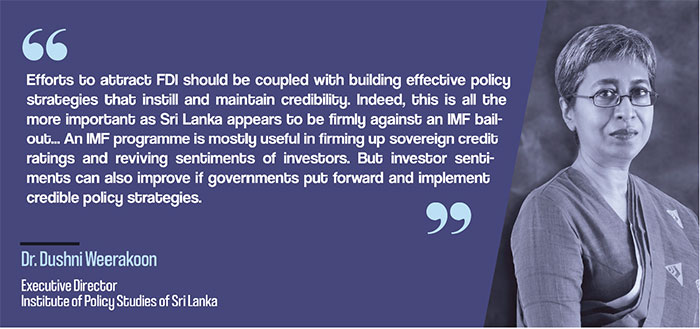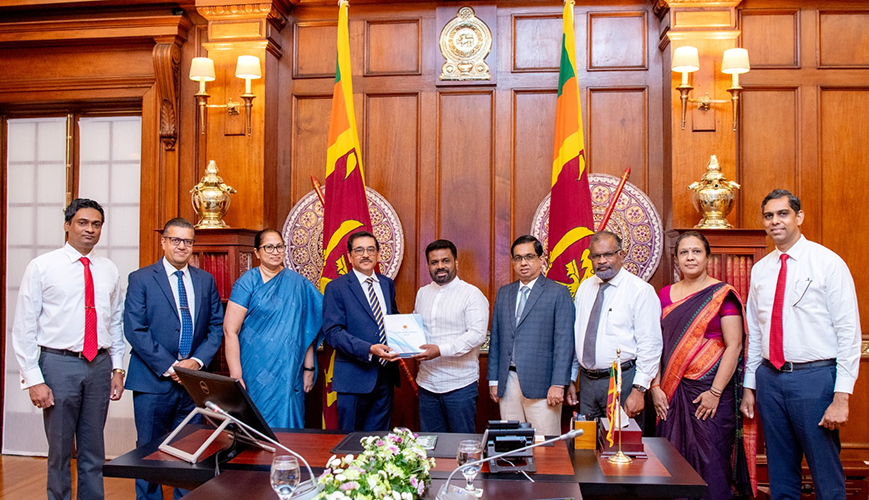Business
Sri Lanka’s macroeconomic policy setting: Cohesion or confusion?

By Dushni Weerakoon
The hike in policy interest rates by the Central Bank of Sri Lanka (CBSL) in August 2021 marks a shift from stimulus to exit strategies in the pandemic era. Such recalibrations globally are focused on how to tackle the historically large debt-to-GDP ratios that the COVID-19 pandemic leaves in its wake. At end 2020, advanced economies (AEs) on average had amassed debt to the tune of 120% of their GDP with emerging markets economies (EMEs) trailing some distance at 65% of GDP. As the spotlight moves, the full impacts of the macroeconomic policy measures, hitherto obscured by the urgency to deal with the health crisis, are now coming under greater scrutiny.
Sri Lanka’s debt metrics make an orderly exit more difficult
Many countries, especially AEs, exercised their ‘monetary sovereignty’ to create and print their own money to support stimulus efforts. They have done so through coordinated monetary/fiscal policies – i.e. using monetary policy to keeping borrowing costs low while fiscal authorities provide back-stop assurance. Some are better positioned to manage the inherent risks and conflicts of interest that are involved in this exercise. AEs have an advantage as issuers of reserve currencies with global demand and historically low interest rates; EMEs with limited exposure to foreign currency-denominated debt and holding comfortable stockpiles of reserves are less exposed to disruptive tail events.
Such countries can bring down their debt ratios if they are able to maintain nominal GDP growth persistently above the average interest rates that they pay on their debt – i.e. the growth-corrected interest rate (r-g) whereby countries can run modest primary deficits and still have a stable or falling debt-to-GDP ratio.
Sri Lanka is not similarly positioned. Its debt metrics point to high vulnerabilities – a high debt-to-GDP ratio of 101% of GDP, large exposure to foreign currency-denominated debt, and a hefty foreign debt repayment schedule. Under these conditions, the threat from exercising monetary sovereignty was always self-evident. A depreciating currency, notwithstanding distortionary controls on imports and capital flows, worsens the debt vulnerabilities.
Domestic and foreign debts are hardly similar. Given Sri Lanka’s debt metrics and the fundamental economic imbalances that have generated them, simple accounting identities do not always offer very plausible solutions. If the exchange rate depreciates, it adds to the real value of outstanding debt, relative to the size of the economy, even if interest rates remain modest. Further, shocks like COVID-19 raise risk premia, and marginal borrowing costs can rise suddenly and sharply, cutting countries abruptly out of financial markets.
Crucial to instill and retain macroeconomic policy credibility
 Short of distortionary measures such as inflating debt away or maintaining an overvalued currency, a primary surplus is needed to stop the public debt-to-GDP ratio from rising and an even larger surplus is needed to reduce it. Improving the primary budget balance calls for tax increases or public spending cuts that are unpopular and have upfront costs. Given the government’s unwillingness to go down this path, households and firms will be required instead to bear the cost through higher interest rates that will affect their consumption and investments.
Short of distortionary measures such as inflating debt away or maintaining an overvalued currency, a primary surplus is needed to stop the public debt-to-GDP ratio from rising and an even larger surplus is needed to reduce it. Improving the primary budget balance calls for tax increases or public spending cuts that are unpopular and have upfront costs. Given the government’s unwillingness to go down this path, households and firms will be required instead to bear the cost through higher interest rates that will affect their consumption and investments.
Higher interest rates in this instance will also not ‘pull in’ foreign capital to firm up the exchange rate given the risk premia on the currency front as depreciating pressure deepens. With reserves in hand to cover barely two months of imports, the forex market will continue to face volatility and instability until a steady stream of capital inflows, beyond short-term swaps, emerge. Until such time, a depreciating domestic currency will increase the interest burden as calculated in that currency. If debt servicing interest rate costs are pushed persistently above the economic growth rate, Sri Lanka’s debt burden will grow steadily even in the absence of new borrowing – a context sometimes called a ‘debt spiral’.
Without a clearly spelt-out debt sustainability path, Sri Lanka seems to be placing all its bets on foreign direct investment (FDI) to ease external pressures and revive economic growth. For a successful outcome – i.e. productivity gains to drive long-term growth – the type of FDI matters. The more desirable is efficiency-seeking FDI, but this is also harder to attract. For now, a policy environment of import curbs and capital controls is more likely to see strategic-seeking infrastructure-led FDI. The latter runs the risk of switching resources to non-tradable sectors – reducing the availability of external financing over the longer term – and the prospect of a short-lived growth burst as before in the post-war years. Crucially too, the sole reliance on FDI leaves Sri Lanka at the mercy of developments beyond its control.
Rather, efforts to attract FDI should be coupled with building effective policy strategies that instill and maintain credibility. Indeed, this is all the more important as Sri Lanka appears to be firmly against an International Monetary Fund (IMF) bailout. IMF loan amounts are small and it no longer has much sway on debt relief with much of EME foreign debt held by private institutional investors and China. An IMF programme is mostly useful in firming up sovereign credit ratings and reviving the sentiments of investors. But investor sentiments can also improve if governments put forward and implement credible policy strategies. By contrast, the CBSL’s policy rate adjustment to anchor expectations, for instance, will not stick if direct financing of fiscal spending is to continue under yield control measures. Instead, market convictions on the credibility of the policy mix will drive economic fundamentals. As Sri Lanka readies to transition out of pandemic-related emergency support, some notion of fiscal and debt sustainability to anchor confidence should be the priority in Budget 2022 preparations.
* This blog is based on the comprehensive chapter on “Economic Performance and Outlook: Managing the Crisis and Promoting Recovery” in IPS’ forthcoming annual flagship publication ‘Sri Lanka: The State of Economy 2021’
.
Link to blog: https://www.ips.lk/talkingeconomics/2021/08/30/sri-lankas-macroeconomic-policy-setting-cohesion-or-confusion/
Dushni Weerakoon is the Executive Director of the Institute of Policy Studies of Sri Lanka (IPS) and Head of its Macroeconomic Policy research. She joined IPS in 1994 after obtaining her PhD, and has written and published widely on macroeconomic policy, regional trade integration and international economics. She has extensive experience working in policy development committees and official delegations of the Government of Sri Lanka. Dushni Weerakoon holds a BSc in Economics with First Class Honours from the Queen’s University of Belfast, U.K., and an MA and PhD in Economics from the University of Manchester, U.K.
Business
Central Bank Presents Annual Economic Review 2024 to President

The Central Bank of Sri Lanka today (07) presented its flagship publication, the Annual Economic Review for 2024 (AER 2024), to President and Minister of Finance, Anura Kumara Disanayake, highlighting the steady progress of Sri Lanka’s economic recovery following the country’s most severe downturn in recent history.
The report was officially handed over by Dr. P. Nandalal Weerasinghe, Governor of the Central Bank, during a special ceremony held at the Presidential Secretariat.
AER 2024 comprises four main chapters: Macroeconomic Developments, Conditions of the Financial System, Review of Central Bank’s Policies and Macroeconomic Outlook.
According to the Review, the Sri Lankan economy showed significant signs of recovery in 2024, following the deep economic crisis experienced two years ago. The recovery trajectory, though challenging, has been notably faster than that of many other debt-distressed countries.
Improvements in economic activity, a partial resurgence in purchasing power and reduced uncertainty are among the key positive indicators noted in the report.
The event was attended by Dr. Nandika Sanath Kumanayake, Secretary to the President, K. M. Mahinda Siriwardena, Secretary to the Treasury, Mrs. K. M. A. N. Daulagala, Senior Deputy Governor, Dr. C. Amarasekara, Assistant Governor, Dr. (Mrs.) S. Jegajeevan, Director of Economic Research and Dr. L. R. C. Pathberiya and Additional Director of Economic Research at the Central Bank Dr. V. D. Wickramarachchi.
[PMD]
Business
IceWarp expands into Sri Lanka, fostering European innovation in collaboration with FentonsIT

IceWarp, a global leader in business communication solutions, has officially launched its cutting-edge platform in Sri Lanka, bringing European expertise in email and collaboration solutions to support the country’s evolving business landscape.
This expansion is driven by a strategic partnership with Fentons Information Technology (FIT), the Information Technology arm of Hayleys Fentons Limited.
The grand launch event held at The Kingsbury Colombo on 4th April, 2025, was graced by several distinguished guests, including Chief Guest Mohan Pandithage, Chairman and Chief Executive of Hayleys PLC.
The presence of Adam Paclt, Global CEO of IceWarp, and Pramod Sharda, CEO for India and the Middle East of IceWarp, along with their global team, highlighted the significance of this expansion. Industry experts, government officials, corporate leaders, and CIOs from the banking, financial services and insurance sectors were in attendance as well, reflecting strong local interest in IceWarp’s European expertise.
With this launch, Sri Lankan businesses now have access to an affordable, scalable and secure alternative to Microsoft 365 and Google Workspace. IceWarp’s advanced Collaboration Suite integrates a wide range of tools into a single, unified platform designed to streamline communication and boost productivity. Offering flexible hybrid deployment options and cost-efficient solution, IceWarp enables organisations to optimise their operations without compromising security or functionality.
Business
Eventistry Sports launches Sri Lanka’s inaugural franchise padel league

Eventistry Sports, a trailblazer in innovative sporting events, has unveiled the Sri Lanka Padel League (SLPL), the nation’s first franchise-based padel tournament, set to debut in June 2025. This groundbreaking league promises to redefine Sri Lanka’s sports landscape by creating a dynamic national platform for athletes while fostering unity among fans, brands, and communities.
The SLPL will showcase six franchise teams, each embodying the spirit of iconic Sri Lankan locales: the Colombo Chargers, Yala Rangers, Hikkaduwa Riders, Ella Hawks, Arugambay Vipers, and Trinco Warriors. These teams will not only ignite regional pride but also unite the country through a shared passion for padel—a fast-paced racquet sport merging tennis and squash, played on enclosed courts.
“The SLPL is more than a league; it’s a movement,” declared Karin Wijeratne, Director of Eventistry Sports. “By blending franchise sports with Sri Lanka’s vibrant culture, we’re creating a platform where players gain national recognition, fans rally behind their hometown heroes, and brands engage with communities in meaningful ways.”
The league’s launch on June 21–23, 2025, at Colombo’s Padel House courts (CR&FC) will kick off with three days of high-octane matches, preceded by a star-studded player auction on May 16th at The Vault, Colombo City Centre. Local talent—both professional and intermediate—will be drafted by franchise owners, with international registrations now open to elevate the competition’s global appeal.
Please log in to: www.slpadelleague.com and social media: @SriLankaPadelLeague (Facebook & Instagram) for more information.
-

 Business19 hours ago
Business19 hours agoColombo Coffee wins coveted management awards
-

 Features2 days ago
Features2 days agoStarlink in the Global South
-

 Business3 days ago
Business3 days agoDaraz Sri Lanka ushers in the New Year with 4.4 Avurudu Wasi Pro Max – Sri Lanka’s biggest online Avurudu sale
-

 Business4 days ago
Business4 days agoStrengthening SDG integration into provincial planning and development process
-

 Business3 days ago
Business3 days agoNew SL Sovereign Bonds win foreign investor confidence
-

 Sports5 days ago
Sports5 days agoTo play or not to play is Richmond’s decision
-

 Features2 days ago
Features2 days agoModi’s Sri Lanka Sojourn
-

 Sports4 days ago
Sports4 days agoNew Zealand under 85kg rugby team set for historic tour of Sri Lanka











